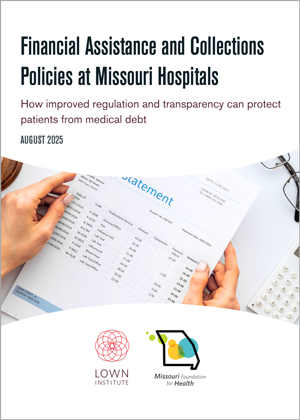Financial assistance and collections policies at Missouri hospitals
Findings from a statewide analysis of Missouri hospital policies
About this project
Medical debt impacts about half of Missouri adults, leading to unnecessary financial and health harms. The Lown Institute examined the financial assistance policies of 163 Missouri hospitals to better understand how hospital policies differ in their eligibility requirements, and how the way hospitals offer assistance and collect debt may impact medical debt in the state. This project is supported by the Missouri Foundation for Health.
View the report
Financial assistance—discounts that hospitals give to low- and middle-income patients—can help prevent medical debt before it starts. But only if these policies are clear, generous, well-advertised, and implemented widely enough to serve the community need.
Key findings
Our analysis of financial assistance policies at 112 general hospitals and 51 specialty hospitals in Missouri shows gaps in transparency and accessibility when it comes to billing and collections.
Low awareness
Most Missouri hospitals offer financial assistance, but patients don’t know about these programs. Despite most Missouri general hospitals (96%) offering financial assistance of some kind, only 24% of Missouri adults report receiving information about these programs from a provider.
Utilization gap
Most Missouri hospitals offer free care for patients making 200% of the federal poverty level (FPL) (about $50,000 for a family of three) and discounted care at or above 300% FPL ($76,000). That’s higher than the state median family income of around $68,000.
This indicates that families at or under the state median income should be able to access some kind of discount on care at most hospitals. However, only 16% of Missouri adults have actually received financial aid through these programs, indicating significant barriers to access.
Additional obstacles to assistance such as residency requirements, restrictions based on insurance status, asset tests, and fees exacerbate these barriers.
Same city, different policies
Although most hospitals offer free or discounted care to patients, there was still variation in policies. Even some hospitals within the same city had different thresholds for eligibility for financial assistance.
Hospitals in the same cities with different free care thresholds
| City | Free care threshold |
|---|---|
| Kansas City | |
| Saint Luke’s Hospital of Kansas City University Health Truman Medical Center | 200% FPL ($50k for family of three) 300% FPL ($76k for family of three) |
| Springfield | |
| Cox Medical Center South Mercy Hospital Springfield | 100% FPL ($25k for family of three) 200% FPL ($50k for family of three) |
| Jefferson City | |
| SSM Health St. Mary’s Hospital Capital Region Medical Center | 200% FPL ($50k for family of three) 250% FPL ($63k for family of three) |
| Columbia | |
| Boone Hospital Center University of Missouri Health Care | 200% FPG ($53k for family of three) 250% FPL ($63k for family of three) |
Aggressive collection actions
The lack of information on what types of aggressive collection activities hospitals allow can expose patients to harm.
Nearly half of Missouri residents with medical debt report facing a negative outcome from an aggressive collection activity, such as being contacted by a collection agency or seeing their credit score go down. However, most Missouri hospitals do not make any information available online about whether or not they conduct these activities and transparency rates lagged behind the U.S. average for every collection action reviewed, making it more difficult for patients trying to avoid financial harm due to medical debt.
Extraordinary collection actions allowed by Missouri general hospitals
| Legal actions | Reporting debt to credit agency | Selling debt to third party | Denying non-emergency care | |
|---|---|---|---|---|
| Allowed according to policy | 50 (45%) | 45 (40%) | 3 (2.7%) | 2 (1.8%) |
| Not allowed according to policy | 1 (0.9%) | 12 (11%) | 2 (1.8%) | 1 (0.9%) |
| Not done in practice, according to hospital representative | 9 (8.0%) | 1 (0.9%) | 11 (9.8%) | 14 (13%) |
| No information US national rate | 52 (46%) 39% | 54 (48%) 43% | 96 (86%) 69% | 95 (85%) 74% |
Driving disparities
Differences in hospital policies may increase medical debt for rural residents and non-English speakers. Most general hospitals in Missouri (88%) make their FA policy available online, but for-profit, public, and rural hospitals have lower rates of transparency. Fewer than 40% of public hospitals and rural hospitals make their policies available in multiple languages. Rural and public hospitals had less generous policies overall.
Policy solutions
Policy solutions to address these transparency and accessibility gaps include: Better notifications of financial assistance, reporting requirements, minimum eligibility thresholds, patient screening requirements, and limits on allowed extraordinary collection actions. Policies should apply to hospitals of all types, to address lower financial assistance availability at public hospitals in rural areas.

